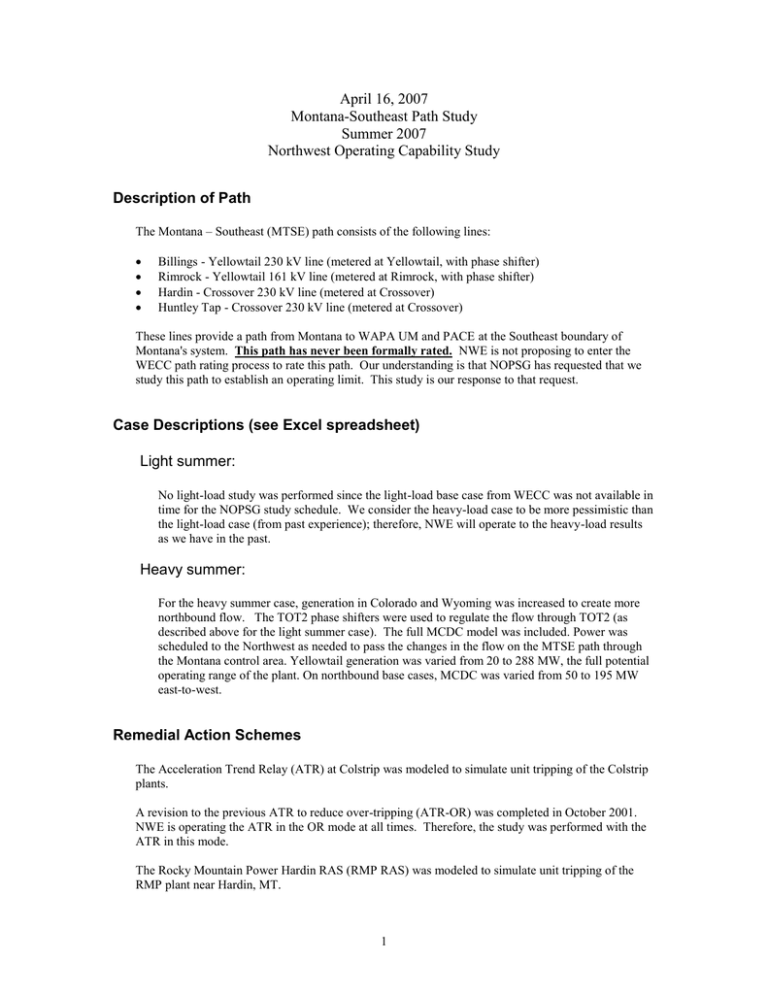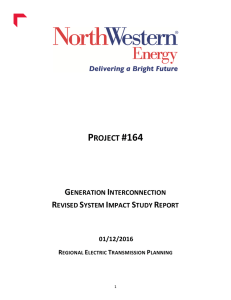Montana_MTSE_summer07_final Updated:2011-03-30 11:31 CS
advertisement

April 16, 2007 Montana-Southeast Path Study Summer 2007 Northwest Operating Capability Study Description of Path The Montana – Southeast (MTSE) path consists of the following lines: Billings - Yellowtail 230 kV line (metered at Yellowtail, with phase shifter) Rimrock - Yellowtail 161 kV line (metered at Rimrock, with phase shifter) Hardin - Crossover 230 kV line (metered at Crossover) Huntley Tap - Crossover 230 kV line (metered at Crossover) These lines provide a path from Montana to WAPA UM and PACE at the Southeast boundary of Montana's system. This path has never been formally rated. NWE is not proposing to enter the WECC path rating process to rate this path. Our understanding is that NOPSG has requested that we study this path to establish an operating limit. This study is our response to that request. Case Descriptions (see Excel spreadsheet) Light summer: No light-load study was performed since the light-load base case from WECC was not available in time for the NOPSG study schedule. We consider the heavy-load case to be more pessimistic than the light-load case (from past experience); therefore, NWE will operate to the heavy-load results as we have in the past. Heavy summer: For the heavy summer case, generation in Colorado and Wyoming was increased to create more northbound flow. The TOT2 phase shifters were used to regulate the flow through TOT2 (as described above for the light summer case). The full MCDC model was included. Power was scheduled to the Northwest as needed to pass the changes in the flow on the MTSE path through the Montana control area. Yellowtail generation was varied from 20 to 288 MW, the full potential operating range of the plant. On northbound base cases, MCDC was varied from 50 to 195 MW east-to-west. Remedial Action Schemes The Acceleration Trend Relay (ATR) at Colstrip was modeled to simulate unit tripping of the Colstrip plants. A revision to the previous ATR to reduce over-tripping (ATR-OR) was completed in October 2001. NWE is operating the ATR in the OR mode at all times. Therefore, the study was performed with the ATR in this mode. The Rocky Mountain Power Hardin RAS (RMP RAS) was modeled to simulate unit tripping of the RMP plant near Hardin, MT. 1 The BPA RAS scheme described in Standing Order 319 trips the MCDC converter and two reactors at Garrison as prescribed in this standing order. Note that the MCDC converter does not trip for Broadview-Garrison switching events. Disturbances As with the studies in the past, NWE used the Broadview-Garrison double outage as the limiting event for the summer 2007 MTSE OTC. Yellowtail Generation Two levels of Yellowtail generation were studied (20 MW and 288 MW) based on indications from WAPA that this was appropriate. However all appropriate MTSE values are easily derived from the Summer 2007 nomograms for any level of Yellowtail generation. Study Results (Excel sheet “Results” and “Graphs”) Southbound: This path was studied (full study) in the southbound direction from the summer of 1999 through the summer of 2001. Each study indicated that a 600 MW OTC is appropriate. The path is no longer studied in the southbound direction since nothing that affects the OTC has changed. The 600 MW OTC is split with 400 MW at Yellowtail and 200 MW at WAPA (Crossover), these limits are set by the phase shifting transformers in the Billings and Yellowtail lines. An internal operational procedure to open the Colstrip – Hardin 115 kV line to mitigate for a slight transformer overload (of the Hardin transformer), is implemented when southbound flows surpass approximately 300 MW. This procedure does not affect the OTC or anything outside of NWE’s system. This OTC does not depend on whether the heavy or light case was used. The North-to-South influence of Yellowtail generation is not tested because increasing Yellowtail can overload the Yellowtail-South path. The southbound flow on MTSE may often be limited by the ability of the Yellowtail-South path to absorb the flow (depending on generation at Yellowtail). Northbound: All buses in the Summer 2007 OTC base cases meet WECC criteria for all MTSE nomogram corner points for the Broadview-Garrison double 500 kV outage. Previous study work has shown that the OTC of the MTSE path is sensitive to (1.) the amount of generation at the Yellowtail plant, (2.) the generation at Colstrip, (3.) the load levels in Montana and Wyoming (heavy or light), and (4.) the MCDC flow. While this list is probably not comprehensive, it represents the most important set of items to which this OTC is sensitive. All four of these dependencies were evaluated in this study. The attached nomograms and operating procedures reflect the influence of each of these variables on the OTC for this path. The flows on many important WECC paths are monitored for each power flow case that is produced for this study. Two very important paths that are monitored are the TOT4A and TOT4B paths (Paths 37 and 38). Care was taken to observe that these paths were not overloaded. The actual flows on these two paths are included in the power flow results tables. 2 Heavy Load: The heavy load nomogram shows that the OTC varies from 113 MW to 443 MW as the Yellowtail generation varies from 20 to 288 MW with the MCDC at 50 MW east-to-west, and with the Colstrip generation at full load. It also shows the OTC varies from 282 MW to 549 MW as the Yellowtail generation varies through its full range, with the Miles City DC tie flow at 195 MW east-to-west, and with the Colstrip generation at full load. The final set of base cases shows that if Colstrip generation is less than 1800 MW (net) the OTC is 600 MW when the Miles City DC tie flow is at 195 MW regardless of the Yellowtail generation level. Light Load: The light load scenarios would be expected to be significantly more optimistic than the heavy load scenarios. NWE expects to operate under the heavy load nomogram corners. Conclusions The Montana - Southeast path can accommodate flows of 600 MW in the southbound direction in both heavy and light load base cases. The northbound OTC varies for heavy and light load periods for this season and is affected by Yellowtail and Colstrip generation and MCDC flows with the following corner points: Heavy MTSE OTC Colstrip Generation FULL 1800 MW net or less YT = 20 MW OTC = 282 MW OTC = 342 MW YT = 288 MW OTC = 549 MW OTC = 600 MW Q-V Analysis Results: NWE no longer performs a Q-V study for this path since it has been shown that it is limited by transient voltage performance. Past Q-V analysis has always demonstrated that this path has ample reactive margin in all load areas and performs very well in the +5% base cases. A Q-V study measures the ability to reliably serve load without a voltage collapse. The major load center in this area is the Billings division (including Colstrip), which is served by at least three other 230 kV sources and has over 500 MW of local generation (after the units have been tripped at Colstrip). This area has approximately 450 MW load (at peak). When a massive outage such as the study contingency (double Broadview – Garrison) occurs, the remaining system has a tendency to be at higher voltages, since the loss of three out of the four generators at Colstrip will reduce the flows on the 500 kV lines that remain so much that they go well below their surgeimpedance-loading. This generally results in high voltages that have to be mitigated by the switched-shunt reactors on the tertiary windings of the Broadview 500/230 kV autotransformers, not a voltage collapse. This has been experienced in actual practice when the ATR trips three Colstrip units. 3 The table below represents the Summer of 2000 Q-V-analysis. Northbound Yellowtail = 20 MW, MCDC – 195 Broadview - Garrison 1 Broadview – Garrison 1&2 Yellowtail-Crossover 230 -441.5 -290.2 -434.8 0.6 0.6 0.6 Bus Quantity BUFFALO 230 QV Voltage FRANNIE 230 QV Voltage -300.5 0.5 -195.8 0.6 -285.1 0.6 GARLAND 230 QV Voltage -280.7 0.5 -189.4 0.6 -268.9 0.6 GOOSE CK 230 QV Voltage -394.4 0.6 -232.4 0.6 -378.4 0.6 KAYCEE 230 QV Voltage -401.6 0.5 -306.8 0.6 -399.8 0.5 OREBASIN 230 QV Voltage -259.7 0.5 -179.5 0.6 -253.2 0.6 SHERIDAN 230 QV Voltage -393.8 0.6 -234.4 0.6 -378.8 0.6 WILSALL 230 QV Voltage -331.2 0.6 -328.4 0.7 -338.2 0.6 WYODAK 230 QV Voltage -347.6 0.8 -270.0 0.8 -347.7 0.8 * Printed next to MVAR output indicates Q-V Curve minimum not found Answers to specific OTCPG questions The OTCPG questions and answers for Montana Southeast include: 1. When was the last time the path was studied? This path has not been studied for all seasons since 1999; check cases were completed in Spring 2003. 2. What is the critical season for this path? All three seasons perform similarly, none is critical. 3. Full studies or check cases? All studies to date have been full cases except for spring of 2003. The 2007 studies are full. 4 4. What are the impacts of this path on system reliability? Are problems local only or is there potential for cascading outside the local area? This path is located in Eastern Montana. Internal disturbances (including doubles) only cause minor voltage dips in the immediate area. The double contingency outage that is used as the limiting case in this study requires three Colstrip units to be tripped to stabilize the Colstrip system. When three units are tripped and the MTSE path is near its OTC, the rebound from the unit tripping can cause voltage dips in Northern Wyoming. The OTC limits are set by the transient voltage dip performance either in Montana or in Northern Wyoming. The path is fully controlled by the three (3) phase-shifting transformers in the Yellowtail-North path and the DC Tie at Miles City. No cascading is experienced in any of our study work at the transfer levels recommended. 5. What is the limiting factor: transient, reactive, thermal? Transient voltage dips in Montana or Northern Wyoming. 6. Have load and generation changes been accounted for? Yes – except for the unavailability of the light-load case. 7. Is it appropriate to study this path in the OTCPG arena? Yes. Additional Comments Thermal Rating (reflected in existing operating procedures) It should be noted that any outage that called for a quick reduction in the flow on the MTSE path could be accommodated by adjusting the phase-shifting transformers at Billings, Rimrock, and Crossover, and by the Miles City DC tie flow. For this reason, traditional issues such as momentary overloading that may occur immediately after lines are opened are not significant. Of course, the initial transient event must perform. The most critical thermal situation is when Montana-Southeast is southbound and PacifiCorp is operating Yellowtail-South per their nomogram. In this situation, the loss of the Yellowtail Frannie 230 kV line may overload the 115 kV line from Greybull to Lovell. This overload can be relieved in the 5-10 minute time frame by the methods described above. WAPA owns the 115 line as well as the Yellowtail generation and is prepared to handle this local thermal problem, that has no potential to cascade. For years, Montana’s operating procedures for southbound MTSE have specifically stated how to coordinate with WAPA and PacifiCorp to eliminate Yellowtail-South overloads. PacifiCorp and WAPA both participate in the Rocky Mountain OTC sub-regional study group, which reviews Wyoming transmission. 5 Colstrip Townsend 500kV (Garrison) Colstrip 500kV Judith Gap 230 Harlowton1 100 Harlowton2 100 Wilsall 230 Clyde Park 161 Hardin 230 Billings 230 Huntley 230 Crossover 230 MTSE Rimrock 161 YTP 230 Miles City DC YTBR 230 YTBR Generation Lovell 115 Frannie 230 Goose Crk 230 YT 115 Montana Power Attachment 1 6



